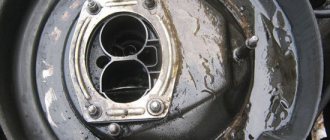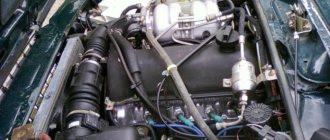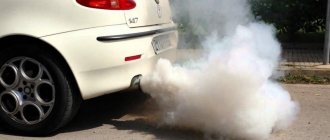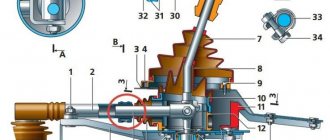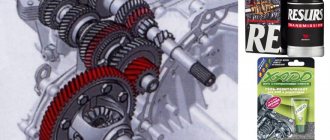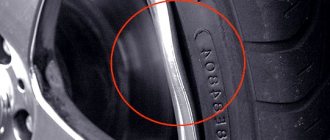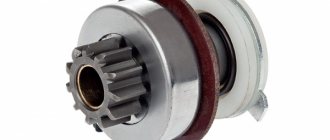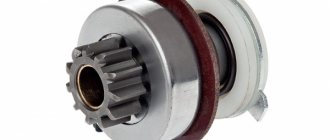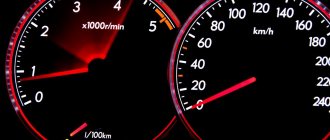20.02.2020
| (Votes: 1, Rating: 5) |
Issues discussed in the material:
- Why does my car smell like gasoline?
- Why does your car smell like gasoline when it’s cold or when it’s hot?
- Why does my car smell like gasoline after filling up?
- What car owners say about why their car smells like gasoline
The situation when the car smells of gasoline is not so uncommon for owners of used cars from the domestic and foreign auto industry. The danger of driving with such a smell is obvious: the driver’s well-being will not improve from regular contact with gasoline vapors, and with a strong and constant smell, there is a high risk of fire.
But if the consequences are clear, then there can be quite a few reasons for the smell of gasoline in the cabin. Some of them are related to the circumstances of starting the car: it is started after parking or without allowing the engine to cool down, sometimes the smell appears after visiting a gas station, and in some cases it is not related to either the starting conditions or the amount of fuel in the tank. Our article will help you understand the reasons.
Why does my car smell like gasoline?
We will consider the reasons that may arise immediately after repair or unexpectedly in any situation, regardless of the conditions of starting the car or visiting a gas station.
Leaky connections of the fuel level sensor
One of the most common reasons for the smell of gasoline in a car is leaking joints in the fuel system. This defect is most relevant for VAZs with front-wheel drive. The peculiarity of these cars is that the fuel system connection is located under the rear seat. To perform the check, you need to lift the rear seat cushion and fold down the inspection hatch. After this, you need to tighten all the threaded connections that relate to the fuel line.
Wear of the fuel pump inspection hatch
This situation is relevant for cars equipped with injection engines. They have a cap fixed on the gasoline tank, to which the fuel pump and fuel level sensor are attached, located inside the gas tank. The lid is held on the tank with screws, and a sealing material is placed directly under the lid. It is this that becomes unusable over time and begins to leak gasoline vapors.
The carburetor is not adjusted correctly
Cars equipped with a carburetor engine can consume much more fuel. The reason lies in an incorrectly configured carburetor. Excess fuel does not burn, but ends up under the hood, the residue evaporates and has a strong, specific smell of gasoline. The smell penetrates into the interior of the car, especially in the cold season when the stove is running.
Owners of carburetor cars usually use a choke (to increase the amount of gasoline in the carburetor) to start the engine more gently. In such a situation, you can easily make a mistake and supply excess gasoline - its smell will certainly get into the cabin.
We recommend
“The car smells like rubber: causes of the smell and ways to eliminate it” Read more
Separator
There are models of vehicles from the domestic automobile industry that are equipped with a so-called gas tank separator. Its design is extremely simple and effective: it is a small sealed plastic container mounted above the neck of the gas tank. The main function of the separator is to equalize the pressure in the gas tank. Gasoline vapors settle on the inner surface of the container and fall back into the tank. For greater efficiency, the separator uses a two-way valve.
The container of the separator itself is made of durable plastic, but sometimes a crack forms on the body under the influence of various unfavorable factors. This leads to the fact that gasoline vapors can enter the car interior.
Clogged catalyst
An automobile catalyst performs the function of afterburning the exhaust with remaining gasoline to the required state of inert gas. Over time, due to constant use or fatigue, the carburetor stops performing its tasks and begins to pass gasoline vapors through the entire system. This way, fumes enter the environment and can easily enter the cabin through the ventilation system.
Rear door seal
Modern cars are equipped with fuel tanks, the neck of which is located on one side of the rear of the body; car enthusiasts call this place “rear fenders”. When refueling a car, a small amount of gasoline vapor enters the atmosphere; if the seal on the rear passenger door, where the fuel tank is located, has defects and allows air into the cabin, then there is a high probability that there is a strong smell of gasoline in the car interior.
Gasoline getting into the cabin
This is a fairly simple and obvious reason that occurs when gasoline is transported in metal cans in the passenger compartment or trunk of a car. If the cap seal requires replacement and there is a fuel leak or there are gasoline residues on the body of the canister itself, even a small amount will be enough to fill the car interior with a strong smell of gasoline. The reason is obvious, just eliminate the source and the problem will be solved.
Poor quality gasoline
Unfortunately, sometimes you have to refuel with low-quality gasoline. Then the most likely situation is that the remains of unused gasoline enter the environment and spread both around the car and inside. Spark plugs tell you about the quality of gasoline. If you unscrew the spark plug and see that its lower part is covered with red soot, you can say with 100% certainty that you filled in low-quality gasoline.
It should also be noted that the use of bad gasoline negatively affects the general condition of the entire fuel system. Choose only gas stations of proven and reliable operators, refuel where they value their customers and the company’s image.
What to do after fixing the problem
Once the reason has been found that caused the unpleasant gasoline aroma to spread throughout the interior of the car, it is imperative to clean this very interior. That is, to get rid of the remaining odor that is probably present there, since gasoline vapors are very volatile and easily eat into a variety of materials (and especially fabric ones), making themselves felt for a long time. And sometimes getting rid of this smell is not easy.
Car owners use a variety of means and methods for this - fragrances, dishwashing detergents, vinegar, baking soda, ground coffee and some other so-called folk remedies. However, it is best to use chemical interior cleaning or ozone cleaning for this purpose. Both of these procedures are performed in specialized centers using appropriate equipment and chemicals. Performing the mentioned cleanings is guaranteed to get rid of the unpleasant smell of gasoline in the interior of your car.
How to get rid of the smell of gasoline
Is there an unpleasant smell of gasoline in the car interior? Getting rid of it is quite simple. There are 9 effective methods. To eliminate the gasoline smell: baking soda, vinegar, coffee. The most effective is... But first, identify the source Read more
Conclusion
Remember that gasoline vapors are very harmful to the human body . Therefore, if you detect the slightest smell of gasoline in the cabin, and even more so if it appears on a regular basis, immediately carry out a set of measures to find and eliminate the causes of this phenomenon. Also, do not forget that gasoline vapors are flammable and explosive. Therefore, when performing the relevant work, be sure to follow fire safety rules . It’s better to work outside or in a well-ventilated area so that gasoline vapors do not enter your body.
Additional
Why does your car smell like gasoline when it’s cold or when it’s hot?
It should be kept in mind: if gasoline vapors enter the cabin after starting the injector, this is not always a sign of a breakdown. An unpleasant odor appears after a so-called cold start in winter and gradually disappears as the engine warms up. If you observe something like this, you can assume that:
- The ECU reads information coming from a temperature sensor, which is located directly inside the motor: it signals the low temperature of the unit;
- taking the received information as a basis, the control unit issues a command to significantly enrich the fuel, and this significantly increases the speed;
- When operating on a rich mixture, fuel entering cold engine cylinders does not burn completely.
In this case, the smell that the driver feels comes from the exhaust pipe. Warming up the engine will allow you to use fuel more efficiently, and after 2-3 minutes the smell will disappear. For most cars, this situation is considered normal.
But in some cases it is still necessary to talk about a breakdown, especially if we are talking about modern cars that were developed according to Euro-4 or higher standards. Partial combustion of gasoline occurs not only due to over-enrichment of the fuel, which is necessary to ensure stable operation during a cold start; other reasons are also possible.
We recommend
“The car smells like burnt rubber: 3 possible reasons” Read more
Possible malfunctions in the car - problems with the ignition system, problems with compression in the cylinders and a dozen other problems - can lead to incomplete combustion of the mixture. In such cases, significant excess fuel consumption is common. Added to this is the fact that the engine is running rough, begins to lose power greatly, and in some cases it may start to smoke.
Simply put, if the smell of gasoline appears during operation, then this is a direct indication that the fuel is not being burned completely. In this case, an in-depth diagnosis is carried out at a service station. The technicians check the spark plugs and ignition coil, wires and other important elements.
Don't forget to check the ECM sensor (also called the oxygen sensor). When diagnosing it, the current condition of the air filter is assessed and the condition of the injection nozzles is analyzed. It is also worth checking the tightness of the system for airing.
Failure to seal the injectors is often the cause of the smell of gasoline on injection engines. In this case, the tightness is restored through the use of new o-rings - they are dense rubber products that can become unusable over time.
Faulty catalyst
The task of the catalytic converter is to burn off the fuel vapor remaining in the exhaust gases. To do this, it must heat up to operating temperature, which on average ranges from 600 to 800 degrees. This takes time. Therefore, in the first minutes after starting the engine, the catalyst is simply not able to clean the exhaust. In this case, a slight smell of gasoline is normal.
If this is observed with a heated catalyst, it is necessary to check its condition. In case of burnout, the element will have to be replaced with a new one.
By the way, many drivers get rid of catalysts altogether.
Why does my car smell like gasoline after filling up?
No less common is the case when the smell of gasoline appears in the car after refueling it. It may disappear, be sharp or barely noticeable. What is the reason?
Every driver will tell you that such problems never arise in a fully functional car. When an odor appears, you must immediately find out why it is being smelled. As a rule, it is caused by a breakdown in the fuel system, and it is in your best interest to find the location of the breakdown as quickly as possible.
An important point is the time the smell appears after refueling. If it appears immediately, then there may be a malfunction in the gas tank pipes. Most likely, they are simply leaking, that is, they have lost their tightness. Drops of fuel fall on other parts of the car, and the smell penetrates into the cabin. If, at the end of refueling, the filling level of the tank is below the breakdown level, the fuel stops leaking and the smell also disappears.
Another equally common cause of odor may be a problem with equalizing pressure inside the fuel tank. Accumulated fuel vapors do not enter the absorber, as the designers intended, but into the cabin. You can determine that there is a problem with the tube by regularly shutting off the gun at a gas station when gasoline enters the fuel tank.
Another common cause is a faulty fuel pump. It is located directly on the tank, under the rear passenger seat. Usually the problem is a violation of the sealed connection at the place of its installation and fastening. In this case, not only vapors, but also gasoline itself can penetrate inside the car. A sharp and strong smell should alert you - very often this can be observed when the owner fills the tank full.
The cause of the unpleasant odor may also be leaking pipes in the compartment where the engine is located. In this case, the smell persists constantly; it may only weaken a little or become sharper. It all depends on whether the car is stationary or in motion. This malfunction belongs to the “urgent” category, it must be eliminated as soon as possible; operating a car with such a breakdown can lead to a fire and completely destroy the vehicle.
What are the dangers of a fuel leak?
Any fuel is flammable even in the absence of an open flame. Gasoline vapors can ignite from a lit match or lighter right inside the car.
The main dangers include:
- Fire - one spark is enough to ignite fuel vapors right in the cabin. At the same time, extinguishing such a flame will be quite problematic.
- Poisoning – if a person inhales harmful fumes for a long time, he may become poisoned. Nausea, vomiting and dizziness are the first signs of danger. If the problem is not corrected, you may face serious respiratory diseases.
On a note! If there is a fuel leak, consumption will increase, which will significantly impact the owner’s wallet.
What car owners say about why their car smells like gasoline
- Location of the problem “You need to pay attention to the seals on the injectors in the injection engine. My fuel pressure regulator was leaking. Therefore, I closed two contacts on the diagnostic connector: turn on the ignition, and the pump starts working. While it’s working, you need to use a flashlight on the injectors to carefully look at where it’s leaking.”
- It doesn’t always leak
“I also had a strong smell, but I couldn’t figure out where it was leaking. And then they recommended that I remove the seat and see if everything is sealed. As it turned out, you just needed to insert the return hose all the way, and that’s it. Because of the small gap there was a terrible smell and it seemed like there was literally a fountain gushing somewhere.” - Need to check repair areas
“I also had a strong smell of gasoline in the car. A quick inspection did not find the cause. Upon closer inspection, I saw how little gasoline was seeping out at the base of the fuel pump fitting, which three years ago was broken off when changing the fuel filter and sealed with epoxy glue. During exposure to it, the glue became brittle and brittle, began to crumble and did not provide 100% tightness. As a result, I had to re-glue the fitting again.”We recommend
“What additives are added to gasoline: detailed information, the best compositions” Read more
- Checking the Hoses
“You need to carefully inspect the hoses at the fuel connections. This also happened when the hose was not pulled onto the fitting and the clamp did not secure it properly. You just need to feel all the connections with a dry hand while the engine is running - somewhere there will be an incomplete seal.” - Sometimes you can fix it
“I had a persistent smell of gasoline due to soggy rubber seals. When I was changing it, drops of gasoline got in and it began to deform. I barely got the O-ring in. But then it started to stink when the tank was full, and all I had to do was cut the sealing rubber at an angle and shorten it to size.”
Leaky gas tank
The weak point of the tank is the weld connecting the fuel tank to the neck. This is where rust often starts to spread. As a result, a leak may form at the junction.
Image source: ad-cd.net
It is also worth checking the sealing ring of the gas tank cap for leaks. Over time, it becomes stiff or deformed. Sometimes cracks appear on the rubber gasket, which may not be noticed when the lid is unscrewed. But when twisted, they expand and contribute to the appearance of odor.

